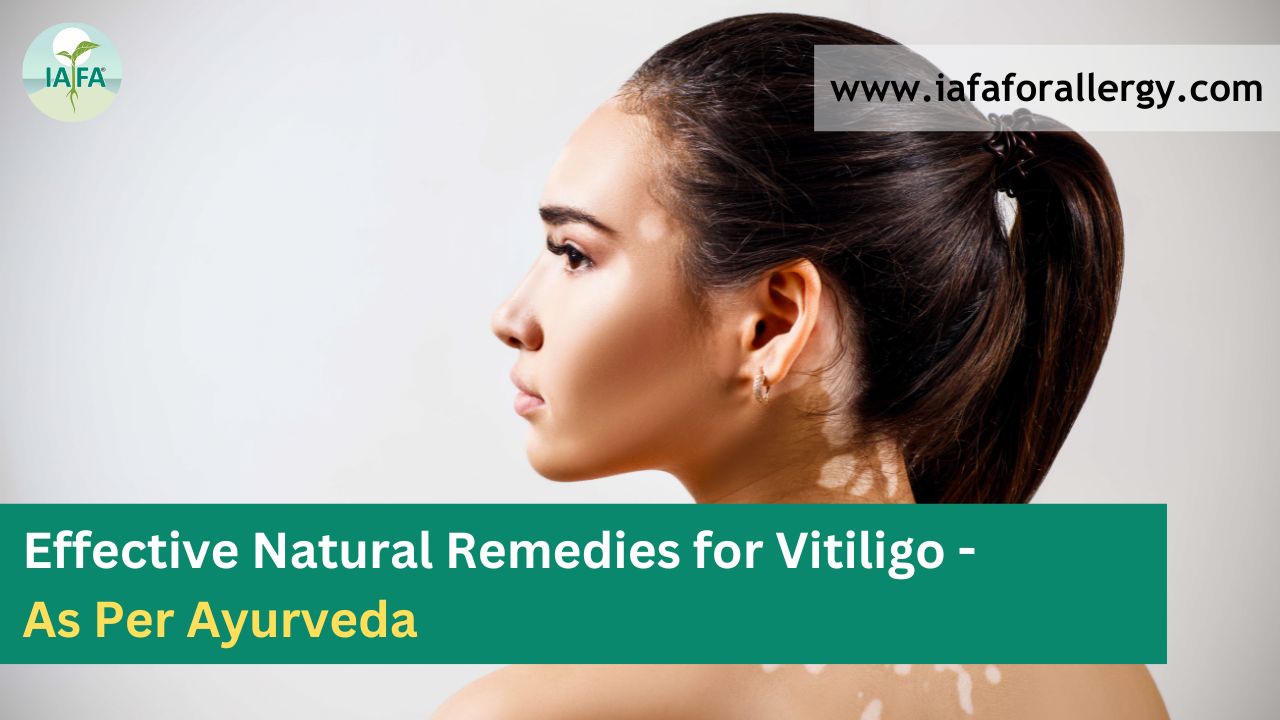What does Ayurveda say about vitiligo?
Ayurveda explains vitiligo as Shwitra Kushta and considers it a skin condition under Kushta Roga. In Shwitra, white patches can be seen on the skin due to an imbalance in the three doshas and a disturbance in the immune system.
What are the Causes of Vitiligo As Per Ayurveda?
The exact cause of vitiligo is unknown but the following can be the reasons for the white patches on your skin:
- Virudh Aahar (foods that are toxic and harmful to the body).
- Vegvidharana (suppression of natural urges like urination, vomiting, etc.,).
- Atibhojana (eating limitless).
- Intake of atyamala (sour), Havana (salty), Madhur (sweet), and pungent foods excessively.
- Excessive Intake of navinanna (freshly harvested grains), dahi (curd), and atimansahar (meat).
What are the Signs and Symptoms of Vitiligo?
The person doesn’t have painful symptoms but the signs can be clear. In some patients we can see red color patches, in some it can be copper in colour and in some, it can be completely white. Ayurveda has the reason for the difference in the colour of the patches.
- Daruna: Red colour patches can be seen in this Rupa because doshas vitiate the Rakta Dhatu (blood capillaries).
- Aruna: Copper colour patches can be seen in this Rupa because doshas vitiate the Mamsa Dhatu (muscle tissues).
- Kilasa: White colour patches can be seen in this Rupa because doshas vitiate the Meda Dhatu (Fat tissue).
Formation of Vitiligo – As Per Ayurveda
Ayurveda considers the imbalance in the three doshas and the effect of this on the Rakta, mama, and media Dhatu resulting in the discoloration of the skin and the appearance of white patches. The imbalance can be due to the intake of virus aahar, stress, bad lifestyle habits, and other causative factors.
What is the Treatment of Vitiligo – As Per Ayurveda
Natural Remedies for Vitiligo?
Ayurveda offers a holistic approach to the treatment of vitiligo by using potent herbs, dietary changes, and lifestyle modifications. These ayurvedic approaches are completely safe and effective in the healing of vitiligo.
Here are some natural remedies commonly used in Ayurveda for vitiligo:
- Bakuchi (Psoralea Corylifolia): Bakuchi is a herb commonly used in Ayurveda for vitiligo treatment. It is believed to stimulate melanin production and promote repigmentation. Bakuchi can be applied topically in the form of oil or used internally. Bakuchi has a history of treating major skin conditions like psoriasis, eczema, and vitiligo. Bakuchi is also used in many herbal medicines for the treatment of various skin conditions.
- Turmeric (Curcuma longa): Turmeric is a well-known golden-hued spice with potential anti-inflammatory and antioxidant properties. It is believed to have skin-healing properties that may benefit individuals with vitiligo. You can incorporate turmeric into your diet or create a paste by mixing turmeric powder with water or oil and applying it topically on the affected areas. Turmeric is extensively used in the treatment of various skin conditions and has produced effective results.
- Guduchi (Tinospora Cordifolia): Guduchi is a herb known for its immune-boosting properties. Ayurvedic practitioners believe that boosting the immune system can help in managing vitiligo. Guduchi can be consumed in the form of capsules, powder, or as a decoction (khada) prepared by boiling the stem of the plant. Disturbed immunity can also be the reason for vitiligo, so correcting the immunity aids in treating the condition and improving the signs.
- Neem (Azadirachta indica): Neem is considered a versatile herb in Ayurveda and is believed to have antimicrobial and immunomodulatory properties. It is used in various forms, such as neem leaves, neem oil, or neem capsules. Applying neem oil topically or consuming neem capsules internally may be beneficial for some individuals with vitiligo. Neem is the best herb for any skin condition and can give the best results.
- Red clay (Sarshapadi): Red clay is believed to have cooling and healing properties. Applying a paste made from red clay and water on the affected areas may help in soothing the skin and promoting repigmentation.
- Aloe vera: Aloe vera gel is known for its soothing and moisturizing properties. It may help in reducing inflammation and supporting skin health. Applying fresh aloe vera gel directly on the affected areas can be beneficial.
Ayurvedic Procedures that Give Visible Results
- Panchakarma: Panchakarma is a set of detoxification procedures that aim to remove toxins from the body and restore balance. It involves a series of treatments, including oil massages (Abhyanga), herbal steam therapy (Swedana), and herbal enemas (Basti). Panchakarma is believed to cleanse the body and improve overall health, which may indirectly benefit individuals with vitiligo.
- Virechana: Virechana is a specialized therapy that involves the administration of herbal purgatives to induce controlled bowel movements. It aims to eliminate toxins from the body and balance the doshas. Virechana is believed to be beneficial in managing skin disorders, including vitiligo.
- Lepa (Topical applications): Various herbal pastes or powders are applied topically on the affected areas in the form of a poultice or paste. These herbal preparations may include ingredients such as turmeric, neem, bakuchiol, or other herbs believed to promote pigmentation and healing.
Dietary Changes
Ayurveda says that making some noticeable changes in the diet can bring good results in the improvement of the disease condition.
- Antioxidant-rich foods: Antioxidants protect the skin cells from any damage, so include foods like fresh fruits and veggies such as carrots, spinach, citrus fruits, etc., to make your skin healthier from the inside.
- Hydration: Hydration is the key to maintaining healthy skin, balancing doshas, and eliminating toxins from the body. Drinking an adequate amount of water can prevent many harmful diseases.
- Avoid virus aahar: Virudh aahar like preserved foods, refrigerated foods, and packaged and adulterated foods can cause more harm than good. Avoid them and bring healthy alternatives.
- Balanced meals: Anything excess can turn into ama visha (toxins) in your body, so Ayurveda encourages one to have food that is balanced, less in quantity, packed with nutrients, and provide rich nourishment to your body.
The Bottom Line
Vitiligo is caused due to imbalance in doshas, improper immune response, and overactive hypersensitivity reactions. It affects the person’s mental state too, even though the discoloration of the skin can be completely painless to the person. The discouraging of skin can be red, copper, or white based on the effect of the dosha on the blood or fat tissue, or muscles. No matter what the color of the patches, it can be cured if the condition is in the mild stage but if the condition is in the severe stage and is completely spread all over the body, it is difficult to get effective treatment.
At IAFA Dr Sahil Gupta has treated more than 50000+ patients from all over the world and if you’re suffering from vitiligo or any other skin disease, book an online consultation now with Dr Gupta and get successful Ayurvedic treatment for all the allergies, and fungal infections and lifestyle diseases.









